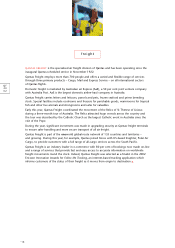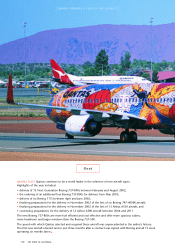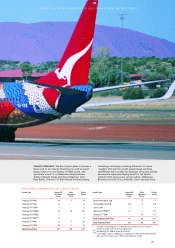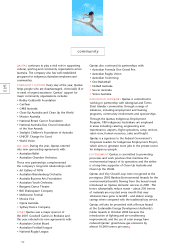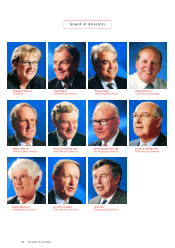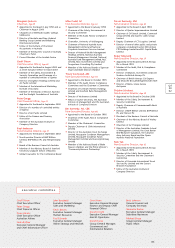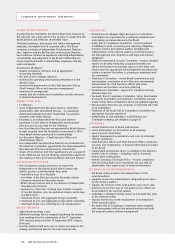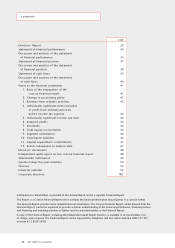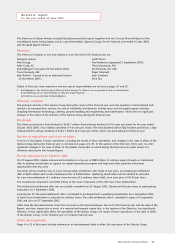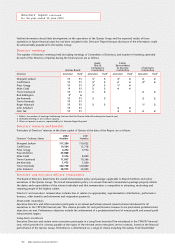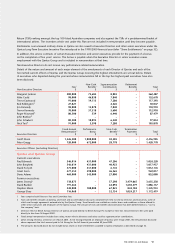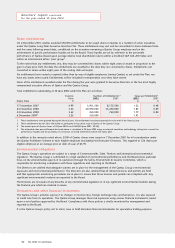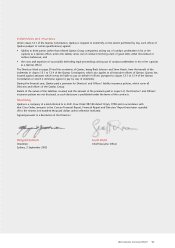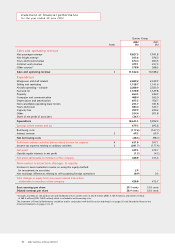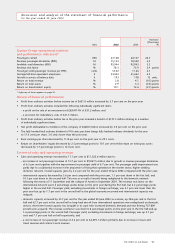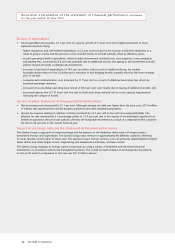Qantas 2002 Annual Report Download - page 28
Download and view the complete annual report
Please find page 28 of the 2002 Qantas annual report below. You can navigate through the pages in the report by either clicking on the pages listed below, or by using the keyword search tool below to find specific information within the annual report.
p26 2002 QANTAS ANNUAL REPORT
BOARD RESPONSIBILITIES
In preparing this Statement, the Qantas Board has focussed on
the structure and values which it has in place to ensure that the
Board protects and enhances shareholder value.
The Board maintains, and ensures that Qantas management
maintains, the highest level of corporate ethics. The Board
comprises a majority of independent Non-Executive Directors
who, together with the BA Directors and Executive Directors,
have extensive commercial experience and bring independence,
accountability and judgement to the Board’s deliberations to
ensure maximum benefit to shareholders, employees and the
wider community.
In particular, the Board:
•
ensures compliance with laws and all appropriate
accounting standards
•sets and reviews strategic direction
•monitors the operating and financial performance of the
Qantas Group
•monitors the performance of the Chief Executive Officer,
Chief Financial Officer and executive management
•monitors risk management
•ensures that the market and shareholders are fully informed
of material developments
BOARD STRUCTURE
•
11 Directors
•seven independent Non-Executive Directors elected by
shareholders other than British Airways – no substantial
shareholder/supplier/customer relationship nor previous
executive roles within Qantas
•Chairman is an independent Non-Executive Director
•maximum 12 year term for independent Non-Executive
Directors and six year term for the Chairman
•two Non-Executive Directors are appointed by British Airways
(a right acquired from the Australian Government in 1993
when British Airways purchased its shareholding)
•two Executive Directors – Chief Executive Officer and
Chief Financial Officer
•
new independent Non-Executive Directors are nominated by
the Chairman’s Committee, appointed by the other independent
Non-Executive Directors and elected by shareholders
•
details of the Directors and their qualifications are on page 25
•at the 2000 Annual General Meeting, shareholders approved
the entering of Director Protection Deeds with each Director
AUSTRALIAN PROVISIONS
•
the Constitution contains provisions to ensure the
independence of the Qantas Board and to protect the
airline’s position as the Australian flag carrier
•head office must be in Australia
•two-thirds of the Directors must be Australian citizens
•Chairman must be an Australian citizen
•British Airways cannot vote in any election of independent
Non-Executive Directors
•quorum for a Directors’ meeting must include a majority
of non-BA Directors who are Australian citizens and at least
one BA Director
•maximum 49 per cent aggregate foreign ownership
•maximum 35 per cent aggregate foreign airline ownership
•maximum 25 per cent ownership by one foreign person
BOARD MEETINGS
•
eight formal meetings a year
•additional meetings held as required (eg during the aviation
crisis resulting from the combination of the 11 September
2001 terrorist attacks and the 14 September 2001 collapse
of Ansett)
•two-day meeting held each year to review and approve the
strategy and financial plan for the next financial year
COMMITTEES
•
Board does not delegate major decisions to Committees
•Committees are responsible for considering detailed issues
and making recommendations to the Board
•Audit, Risk & Compliance Committee – assists the Board
in fulfilling its audit, accounting and reporting obligations,
monitors internal and external auditors (including the
independence of the external auditors), monitors business
risk management and compliance with legal and statutory
obligations
•Safety, Environment & Security Committee – receives detailed
reports on all safety (including occupational health and
safety), environment and security aspects of the airline and
ensures that the appropriate risk management procedures are
in place to protect the airline, its passengers, employees and
the community
•Chairman’s Committee – review Board’s performance and
remuneration, nomination of new Directors, recommends
remuneration for Chief Executive Officer and senior
executives and monitors succession planning
•Nominations Committee – approval of Chairman and any
Alternate Directors
•
the Audit, Risk & Compliance Committee, Safety, Environment
& Security Committee and Chairman’s Committee operate
under formal Terms of Reference which are updated regularly
•Non-Executive Directors are a majority on and hold the Chair
of all Committees
•Chairman of the Audit, Risk & Compliance Committee has
appropriate financial experience
•membership of and attendance at 2002 Board and
Committee meetings are detailed on page 30
STANDARDS
•
annual formal review of Board performance
•active participation by all Directors at all meetings
•open access to information
•regular management presentations and visits to interstate/
offshore operations
•Chief Executive Officer and Chief Financial Officer certify the
accuracy and completeness of financial information provided
to the Board
•independent professional advice is available to the Directors
•formal Code of Conduct – including conflict of interest
•formal share trading policy
•formal Continuous Disclosure Policy – ensures compliance
with the Listing Rules and Corporations Act and that all
shareholders have equal access to material information
EXTERNAL AUDITOR INDEPENDENCE
•
the Board closely monitors the independence of the
external auditors
•
regularly reviews the independence safeguards put in place
by the external auditors
•
requires the rotation of the audit partner every seven years
•
policies to restrict the type of non-audit services which can
be provided by the external auditors
•
undertakes a detailed monthly review of non-audit fees paid
to the external auditor
•
imposes restrictions on the employment of ex-employees
of the external auditor
•
the Audit, Risk & Compliance Committee meets regularly
with management without the external auditors and with
the external auditors without management
corporate governance statement




